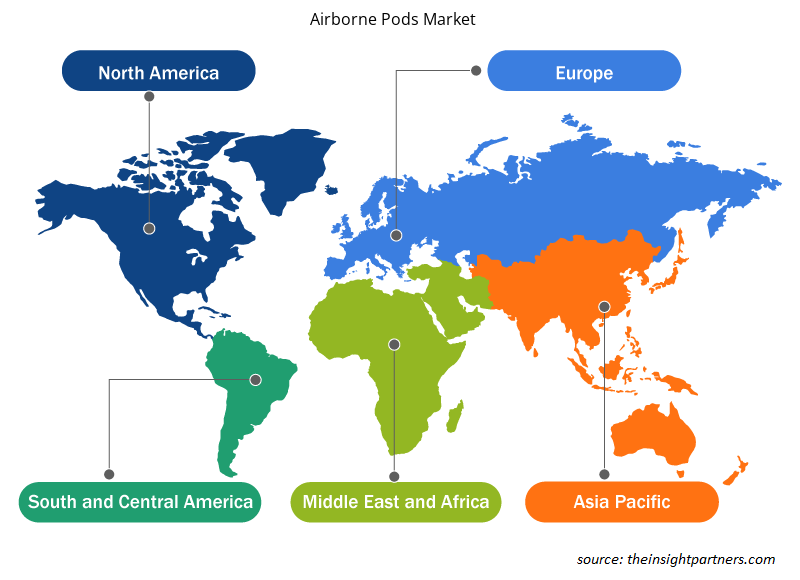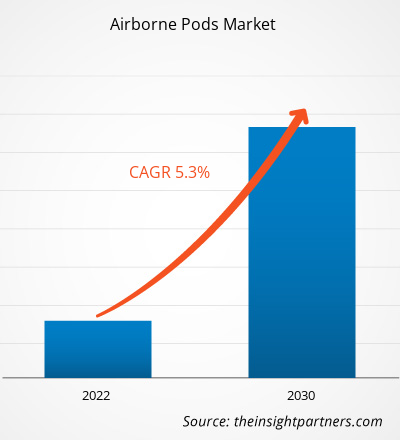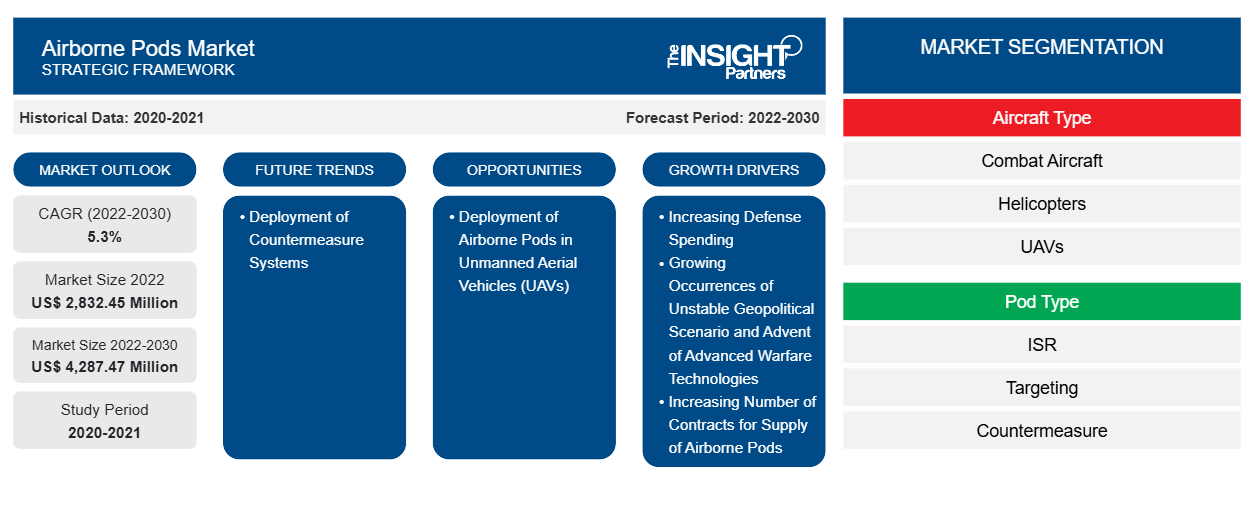机载吊舱市场规模预计将从 2022 年的 28.3245 亿美元增至 2030 年的 42.8747 亿美元。预计 2022-2030 年市场复合年增长率为 5.3%。全球不断变化的地缘政治形势推动了对强大防御对抗系统的需求。对抗系统是机载防御系统,有助于识别空中威胁。防空雷达系统利用来自其他传感器和情报来源的输入,为融合和关联生成重要数据。这加速了全面准确的空中图像的开发,从而实现了精确的威胁评估和目标交战。俄罗斯-乌克兰、印度-巴基斯坦和以色列-巴勒斯坦等国家之间的紧张局势迫使这些国家的政府加强武装力量。
机载吊舱市场分析
各国武装部队都在投资采购防空系统,如地对空导弹系统、综合防空系统、海军防御系统、战斗机、预警系统和边境监视系统。雷达系统是综合防空系统的基本组成部分。它们使武装部队能够跟踪、探测和识别空中威胁,如飞机、无人机和导弹。BAE 系统公司、通用动力公司、霍尼韦尔国际公司、以色列航空工业公司、莱昂纳多公司、洛克希德马丁公司、诺斯罗普·格鲁曼公司、雷神技术公司、萨博公司和泰雷兹集团是少数几家专注于开发包括雷达系统、通信和监视系统以及导航设备的防御对抗系统的公司。因此,对抗系统的采购和部署增加预计将在预测期内推动机载吊舱市场的增长。
机载吊舱市场概况
全球日益不稳定的地缘政治局势是导致军用飞机和直升机上机载吊舱应用增加的主要因素。政府为加强国防部门以应对现代战争需求而采取的举措日益增多,这也导致机载吊舱的应用激增,以改善空中监视、探测、瞄准和空中攻击对抗。能够执行有人和无人任务,同时与领域和陆地之间的大量数据链接传感器集成,这是先进战斗机的一些主要特征。先进战斗机拥有高端航空电子设备、更强大的推力矢量发动机和内置超级巡航。机载吊舱在战斗机中有重要应用;它们收集有关敌人实力、活动和行动的信息。机载情报、监视和侦察 (ISR) 吊舱有助于向空军国防基地提供高度机密的情报数据。战斗机利用瞄准吊舱来探测和攻击地面上追踪的目标。随着技术进步,战斗机上也开始使用自卫吊舱,这种吊舱能够跟踪导弹威胁的红外和无线电频率。因此,它为部署对抗和实时威胁识别与防御系统做好了准备。
定制此报告以满足您的需求
您可以免费定制任何报告,包括本报告的部分内容、国家级分析、Excel 数据包,以及为初创企业和大学提供优惠和折扣
- 获取此报告的关键市场趋势。这个免费样品将包括数据分析,从市场趋势到估计和预测。
机载吊舱市场驱动因素和机遇
增加军用飞机和直升机的采购
为了应对日益增多的空中袭击事件,军用飞机和直升机的采购量不断增加,这推动了全球机载吊舱市场的发展。对先进技术的需求不断增长,以消除导弹袭击,同时增强识别或定位目标区域的过程,以及对可能的空中威胁的监视和检测,这推动了先进机载吊舱在军用飞机、喷气式飞机和直升机上的应用。各国政府机构正在大力投资采购高端军用飞机、战斗机和直升机,以应对日益增长的空中威胁,这也扩大了全球机载吊舱和先进传感器的应用范围。
无人驾驶飞行器(UAV)机载吊舱的部署
无人机越来越多地用于各种目的,包括武器投送、监视和干扰,这增加了对机载吊舱的需求。导航、通信和监视系统对于检测和跟踪无人机以及提供预警和态势感知至关重要。无人机的日益普及需要具有改进的检测能力的先进机载吊舱,以有效对抗空中或地面威胁。随着无人机威胁日益明显,世界各国政府和国防组织优先开发和获取通信和监视防御系统,以应对这种不断演变的威胁。
机载吊舱市场报告细分分析
有助于得出机载吊舱市场分析的关键部分是飞机类型、吊舱类型、传感器技术、范围和地理位置。
- 根据飞机类型,机载吊舱市场细分为战斗机、直升机、无人机等。 2022 年,战斗机领域占据了更大的市场份额。
- 根据吊舱类型,市场细分为 ISR、目标瞄准和对抗。ISR 领域在 2022 年占据了最大的市场份额。
- 就传感器技术而言,市场已分为 EO/IR、EW/EA 和 IRCM。EO/IR 领域在 2022 年占据了市场主导地位。
- 根据续航里程,市场分为短程、长程和中程。2022 年,长程市场占据了最大的市场份额。
空中吊舱市场份额按地区分析
机载吊舱市场报告的地理范围主要分为五个地区:北美、欧洲、亚太、中东和非洲以及南美。
2022 年,北美占据了机载吊舱市场的主导地位,并且在预测期内也有可能保持主导地位。此外,到 2022 年,欧洲占据第二大份额,其次是亚太地区。此外,到 2030 年,亚太地区可能会超过欧洲地区。就国防领域发展而言,欧洲是全球领先的地区之一。乌克兰和俄罗斯等国家之间的地缘政治动荡加剧,推动了空军对能够进行空中探测、识别、通信和瞄准的强大而先进的传感器的需求。中国、印度、澳大利亚、日本和韩国是亚太地区机载吊舱的主要市场。对国家安全的日益关注以及政府为促进空军安全基础设施发展而采取的举措不断增加,是推动亚太地区对机载吊舱需求的几个因素。
机载吊舱市场区域洞察
Insight Partners 的分析师已详细解释了预测期内影响机载吊舱市场的区域趋势和因素。本节还讨论了北美、欧洲、亚太地区、中东和非洲以及南美和中美洲的机载吊舱市场细分和地理位置。

- 获取机载吊舱市场的区域特定数据
机载吊舱市场报告范围
| 报告属性 | 细节 |
|---|---|
| 2022 年市场规模 | 28.3245亿美元 |
| 2030 年的市场规模 | 42.8747亿美元 |
| 全球复合年增长率(2022-2030 年) | 5.3% |
| 史料 | 2020-2021 |
| 预测期 | 2022-2030 |
| 涵盖的领域 | 按飞机类型
|
| 覆盖地区和国家 | 北美
|
| 市场领导者和主要公司简介 |
|
机载吊舱市场参与者密度:了解其对业务动态的影响
空中吊舱市场正在快速增长,这得益于终端用户需求的不断增长,这些需求源于消费者偏好的不断变化、技术进步以及对产品优势的认识不断提高等因素。随着需求的增加,企业正在扩大其产品范围,进行创新以满足消费者的需求,并利用新兴趋势,从而进一步推动市场增长。
市场参与者密度是指在特定市场或行业内运营的企业或公司的分布情况。它表明在给定市场空间中,相对于其规模或总市场价值,有多少竞争对手(市场参与者)存在。
在机载吊舱市场运营的主要公司有:
- 英国航宇系统公司
- 先进技术集团(ATGI)
- L3Harris技术公司
- 洛克希德·马丁公司
- 诺斯罗普·格鲁曼公司
- 雷神技术公司
免责声明:上面列出的公司没有按照任何特定顺序排列。

- 获取机载吊舱市场顶级关键参与者概述
机载吊舱市场新闻和最新发展
机载吊舱市场通过收集一级和二级研究后的定性和定量数据进行评估,其中包括重要的公司出版物、协会数据和数据库。以下是机载吊舱市场的发展和战略列表:
- 2023 年 8 月,RTX 旗下的 Collins Aerospace 公司赢得了美国空军研究实验室的一份价值 3600 万美元的合同,用于开发和演示与平台无关的超视距卫星通信吊舱。(来源:雷神技术公司,新闻稿/公司网站/时事通讯)
- 2022 年 9 月,诺斯罗普·格鲁曼公司的 LITENING 先进瞄准吊舱在美国海军的 F/A-18 超级大黄蜂上成功完成首次试飞。海军选择 LITENING 来取代 F/A-18 舰队上的传统瞄准吊舱。(来源:诺斯罗普·格鲁曼公司,新闻稿/公司网站/通讯)
机载吊舱市场报告覆盖范围和交付成果
“机载吊舱市场规模和预测(2020-2030 年)”报告对以下领域进行了详细的市场分析:
- 范围内涵盖的所有主要细分市场的全球、区域和国家层面的市场规模和预测
- 市场动态,如驱动因素、限制因素和关键机遇
- 未来主要趋势
- 详细的波特五力分析
- 全球和区域市场分析涵盖关键市场趋势、主要参与者、法规和最新市场发展
- 行业格局和竞争分析,涵盖市场集中度、热点图分析、知名参与者和最新发展
- 带有 SWOT 分析的详细公司简介
- 历史分析(2 年)、基准年、预测(7 年)及复合年增长率
- PEST和SWOT分析
- 市场规模、价值/数量 - 全球、区域、国家
- 行业和竞争格局
- Excel 数据集
近期报告
客户评价
购买理由
- 明智的决策
- 了解市场动态
- 竞争分析
- 客户洞察
- 市场预测
- 风险规避
- 战略规划
- 投资论证
- 识别新兴市场
- 优化营销策略
- 提升运营效率
- 顺应监管趋势





















 获取免费样品 - 机载吊舱市场
获取免费样品 - 机载吊舱市场